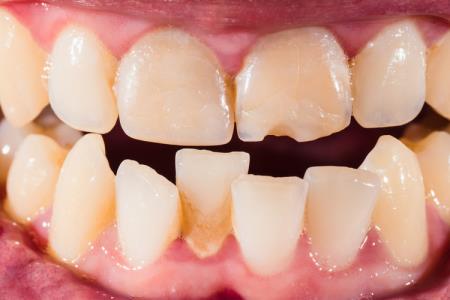Things to know about dental tartar removal
Dental plaque or tartar build-ups happen to everyone. Is there a way to prevent their formation? And how can we get rid of tartar most effectively?
Plaque neither appears out of thin air and nor goes away on its own. Even if you brush and floss your teeth daily and have great oral care habits, food particles still build up on your teeth, resulting in dental plaque over time.
That’s the reason why dentists often recommend you to get tartar removal every 6 months.
What is dental plaque or tartar?
Technically, plaque is a biofilm - a product of micro bacteria. Simply put, plaque is the build-up of a huge amount of bacteria. This means after your teeth spend a certain amount of time biting and chewing foods, plaque will develop.
Without proper oral hygiene, a compound available in saliva called calcium phosphate will interact with these plaque build-ups, hardening them and making them securely stuck to your teeth.
Many people wonder why they can’t completely get rid of plaque even when they brush their teeth right after every meal. The truth is, after you brush your teeth, a film of saliva containing glycoprotein starts to build up.
Although these glycoproteins help protect your teeth, they also create a convenient environment for bacteria to stick to the film. Then, oxygen promotes the growth and proliferation of the original bacteria on this film, leading to plaque formation.
Dental tartar comes in many colors, but most of the time, they are black, orange, or yellow. Newly formed tartar usually has a light yellow or orange color, but it will turn black with time and stick to the root of your teeth. Hardened tartar (which is formed near the gum around the roots and may cause inflammation) has similar colors. However, removing it proves to be more difficult than normal plaque build-ups.

Why is tartar removal necessary?
Dental tartar is the leading cause of various oral diseases such as:
- Periodontitis (symptoms include gum inflammation, easy bleeding, gum recession, alveolar bone resorption, resulting in loose teeth).
- Bad breath.
- Home of many bacteria that thrive on the fermentation of carbohydrates such as streptococcus mutans and lactobacilli, creating acids that can cause cavities.
- Bleeding from the roots, toothaches when eating hot or cold foods.
- Gum recession, resulting in loose teeth.
- Indirectly causing diseases of the mouth and throat such as stomatitis, tonsillitis, mouth sores, etc.
- Damaged enamel due to excessive build-ups of plaque or tartar.
Therefore, it’s crucial to have your dental tartar removed and teeth polished frequently to avoid the aforementioned diseases. Do not wait until after dental tartar has formed since the appearance of tartar means that your teeth have already been damaged. It’s recommended to go for dental tartar removal every 6 months (or 3-4 months in case of severe periodontitis).
Learn more: Tartar Removal: Is It Good?
Who shouldn’t have tartar removal?
- People with oral diseases: If you have one or several cavities that require filling or extraction, deal with that before getting to plaque removal.
- Women who are on their periods: Before your period starts, the level of estrogen hormone in your body increases, which may cause swelling and inflammation of the gum. This has a negative effect on the process of plaque removal (i.e. causing more pain, making your gum more likely to bleed and swell up).
- Children under 6 years old: Tartar is uncommon in baby teeth. Most of the time, it only forms on permanent teeth. Therefore, with children under 6 years old, parents should clean their teeth at home. If you notice anything wrong with their oral health, bring them to pediatric dental clinics.
Professional removal of dental plaque and tartar
Although home remedies for dental plaque and tartar are quite helpful, they can’t replace professional procedures done by dentists. This is because dental plaque and tartar have a rough surface, making it hard to remove the build-ups with just brushing and flossing.
Dental clinics, such as The East Rose Dental (Old Rose Dental Clinic), have all the necessary equipment to remove plaque and tartar and to take care of your oral health. The East Rose Dental (Old Rose Dental Clinic) has a team of highly experienced medical doctors, allowing you to feel safe when having your oral health taken care of.
After dental tartar removal, your teeth will be polished, which brightens them and prevent tartar from coming back.
What to avoid after dental tartar removal?
Many people experience toothaches after having tartar removed. This could be due to sensitive teeth or the dentist’s lack of experience. In addition, poor aftercare is also a major reason. Thus, after plaque or tartar removal, pay attention to the following to help your teeth stay healthy and prevent plaque and tartar from coming back:
- Don’t consume foods or beverages that are too hot or too cold.
- Avoid foods such as fish sauce, mustard and those that are too soft or sticky.
- Drink plenty of water after eating to wash away plaque.
- Rinse your mouth with a saline solution to get rid of bacterial build-ups on your teeth.
- Eat foods that have a cleaning effect such as apples, strawberries, cauliflowers, carrots, etc.
How to prevent the formation of plaque and tartar?

- The best way to prevent plaque by brushing and flossing your teeth frequently. This helps delay the formation of tartar. If tartar does form, it will not be serious.
- Refrain from foods with lots of sugar and carbohydrates as well as those that are sticky and can easily get stuck on the surface of your teeth (such as gummies, syrup taffy candy, chewy sesame peanut candy, etc.). Besides, a diet with smaller meals per day with plenty of snacks also encourages bacterial buildups in your mouth, resulting in dental plaque and tartar.
- Visit your dentist every 6 months to detect any oral diseases early and get appropriate treatment.
How to get rid of dental plaque at home?
You can deal with mild cases of dental plaque by:
- Brushing and flossing your teeth: 30 minutes after your meal, brush your teeth for at least 3 minutes. Remember to brush vertically to remove the plaque hidden in the gaps between teeth. Avoid brushing horizontally as it may wear out the roots of your teeth. It’s recommended to use a toothpaste with fluoride to protect your enamel and prevent cavities. Flossing can be done right after your meal.
- Quit smoking. Studies show that smokers are more likely to get dental tartar than those who don’t smoke. Quitting is a way to protect your teeth and gum.
- If possible, using an electric toothbrush. Dental tartar is the result of plaque build-ups on teeth. Electric toothbrushes are designed specifically to target this problem.
- Using baking soda as a toothpaste: Baking soda is an abrasive agent that helps remove the plaque effectively. Mix water with baking soda and some salt and use this mixture as toothpaste daily.
- Fighting plaque with home remedies such as orange peels, aloe juice mixed with water, baking soda, and lime juice, among others.
- Chewing fresh vegetables is also a surprisingly effective method to cleanse your teeth.
Dental plaque and tartar can happen to anyone. Although you can completely keep them at bay, it’s possible to manage and prevent their formation. Instead of spending 15 minutes for skincare every night, add another 5 minutes to take care of your oral health. A radiant smile with bright teeth will help you shine wherever you are.
Reference source
Services
Working Time
- Monday - Friday: 08:00 - 19:00
- Saturday: 08:00 - 18:00
- Sunday closed
Contact Info
- Hotline 1: (+84) 908 321 455
- Hotline 2: (+84) 931 857 885
- Mobile: (+84) 8 3925 8778
- Phone: (+84)2 838 258 778
- info@dentalrose.net
- rosedentalclinicvn@gmail.com
 English
English  Tiếng Việt
Tiếng Việt

